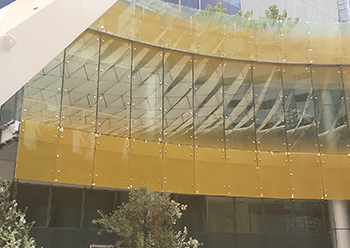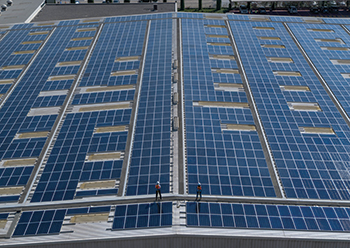
 A Dubai Investments project
A Dubai Investments project
The global flat glass market is expected to grow at a 6 per cent CAGR over the next six years (2022-2028) owing penetration of glass architecture in the residential and non-residential construction industry, according to a latest report.
MARKET DRIVERS
Furthermore, increasing solar energy installations across the globe and growing demand from the automobile industry is expected to boost the market growth. The market size is estimated to be $110 billion in 2022 and is expected to reach $160 billion by 2028, predicts the “Global Flat Glass Market Size, Segments, Outlook, and Revenue Forecast 2022-2028 by Product Type, Technology, End-user and Region” report by ResearchAndMarkets.com.
The rising installation of solar panels across the globe is expected to propel the growth of the global flat glass market. The growing expenditure on the construction industry is further expected to accelerate the growth of the market.
Growth in construction and infrastructure development is directly related to the demand for flat glass, which tends to drive market growth. Recent trends show that the architecture of buildings is changing rapidly, such as the use of flat glass in facades and roofs to optimise natural light. Construction of eco-friendly green buildings, which aid in minimising carbon emissions into the environment, is also driving the flat glass market growth.
MARKET RESTRAINTS
An increase in the cost of raw materials is a major challenge faced by the flat glass market.
The prices of sand, soda ash, and limestone, which are the main raw materials used in the production of glass, have been rising in recent years. This has put pressure on glass manufacturers to increase their prices which in turn affects the end-user industries.
Due to the Covid-19 outbreak, most of the manufacturing plants were closed and automotive production got severely affected. Supply chains around the world had been disrupted. Economic instability prompted both public and private sector developers to pause their projects, which led to the decline of the construction industry.
However, in the medium term, increasing demand for electronic displays, and increasing demand for home appliances such as TVs, smartphones, tablets, laptops, wearables, and other devices boosted the growth of the flat glass market.
KEY TRENDS BY MARKET SEGMENT
 |
Penetration of glass architecture in construction industry is driving growth of the flat glass segment |
By Product Type: The insulated segment dominated the global flat glass market by product type in 2021 and is expected to continue being the dominant segment during the forecast period.
Insulated flat glass is expected to grow as a result of rising demand from residential and non-residential establishments. Products like curtain walls, storefronts, overhead glazing, non-vision locations, and commercial and operable windows are made from insulated flat glasses. Also, this type of glass is used in the manufacturing of photovoltaic modules:
By Technology: The float segment is the highest revenue-generating in the market under review by technology in 2021.
Float glass is manufactured on a floating line where a molten ribbon of glass is made by floating the liquid glass mixture over a bed of molten tin. As it floats over the tin, it is called float glass. The float glass segment requires simple processing. Moreover, the production of float glass can be done on a large scale without compromising on its quality.
By End-user: The construction & infrastructure segment held the largest market share in the global flat glass market by end-user in 2021 and is expected to continue being the dominant segment during the forecast period.
Due to rapid urbanisation and a growing population, construction activities and infrastructural developments are increasing rapidly around the globe. Preference for look and appeal in interiors has augmented the demand for luxury construction which requires usage of glass products in buildings. The use of glass reduces the time taken to construct a structure.
By Region: Asia Pacific accounted for the largest market share in 2021 among all regions within the global flat glass market and is expected to be the dominant region during the forecast period owing to the expansion of the housing construction market in developing countries.
Asia Pacific regional market is anticipated to grow as infrastructure development in the developing countries of the region is expected to boost the market growth over the forecast period. In residential and non-residential establishments, the use of flat glass is very high.
Southeast Asia is also one of the emerging sub-regional markets, with countries such as China and Japan investing heavily in the region. Various automobile manufacturers and consumer electronics manufacturing plants are concentrated in the Asia Pacific region. Consumer electronics devices such as mobile phones, laptops, computers, TV, etc. requires flat glass for its screen.
COMPETITIVE LANDSCAPE
The global flat glass market is highly competitive with over 300 players which include globally diversified players, regional players as well as a large number of country-niche players.
The leading global companies such as AGC Inc., Guardian Industries, and Nippon Sheet Glass Co. Ltd. highly focus on new product launches and expansion of production to increase their market presence.
RECENT DEVELOPMENTS
In September 2020, Guardian Industries inaugurated its second float glass facility in Poland for the production of a technologically advanced new glass coater. The new facility aims at catering to the growing demand for high-performance products in the architectural and construction markets.
In June 2021, Nippon Sheet Glass Co. Ltd. launched its antibacterial and antiviral-coated glass; NSG Purity. These glasses come with antiviral and antibacterial coating and also kill 99.9 per cent of viruses and bacteria and do not allow bacteria to enter homes.
In April 2021, AGC Inc. developed the Smart Inventory System for the automated management of raw materials. The system was fully deployed at its Kansai Plant, Takasago Factory, and Amagasaki Factory. This initiative is expected to promote the handing down of technology & skill among workers and to reduce annual labour hours by 1,000 hours.
The leading players across the global market for flat glass includes companies such as: GSC Glass Ltd (India); AGC Inc. (Japan); Fuyao Glass Industry Group Co., Ltd (China); Sisecam Group (Turkey); Vitro (Mexico); Saint-Gobain (France); Taiwan Glass Industry Corporation (Taiwan); Guardian Glass LLC (US); Changzhou Almaden Co., Ltd (China); Nippon Sheet Glass Co., Ltd (Japan); and Schott AG (Germany).
CONCLUSION
The global flat glass market is forecasted to continue moderate growth, which is primarily driven by increasing glass architecture in the residential and non-residential construction industry. Furthermore, rising solar energy installations across the globe and growing demand from the automobile industry are expected to boost the market growth.

